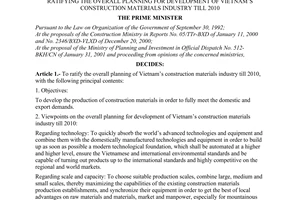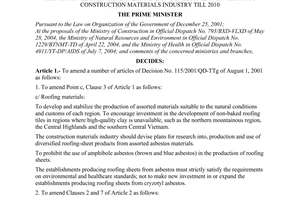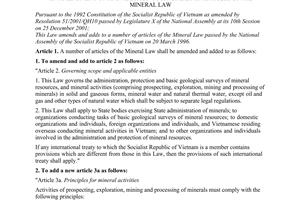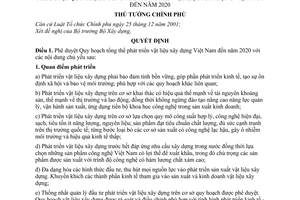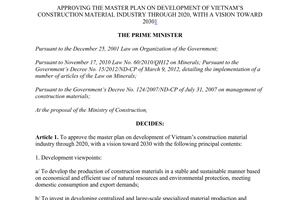Decision No. 121/2008/QD-TTg of August 29, 2008, approving the master plan on development of Vietnams construction materials up to 2020. đã được thay thế bởi Decision No. 1469/QD-TTg development of Vietnam’s construction material industry through 2020 2030 và được áp dụng kể từ ngày 22/08/2014.
Nội dung toàn văn Decision No. 121/2008/QD-TTg of August 29, 2008, approving the master plan on development of Vietnams construction materials up to 2020.
|
THE PRIME MINISTER ---------- |
SOCIALIST
REPUBLIC OF VIET NAM |
|
No. 121/2008/QD-TTg |
Hanoi, August 29, 2008 |
DECISION
APPROVING THE MASTER PLAN ON DEVELOPMENT OF VIETNAMS CONSTRUCTION MATERIALS UP TO 2020
THE PRIME MINISTER
Pursuant to the December 25, 2001 Law on Organization of the Government;
At the proposal of the Minister of Construction;
DECIDES:
Article 1- To approve the master plan on development of Vietnam's construction materials up to 2020 with the following principal contents:
1. Development viewpoints
a/ Developing construction materials in a sustainable manner, contributing to economic development, social stability and environmental protection, and in line with other relevant plannings;
b/ Developing construction materials on the basis of effectively tapping the country's strengths of mineral resources, markets and labor, along with increasingly providing training to raise the capacity to manage and administer production and apply scientific and technological advances to production and business activities;
c/ Developing construction materials on the basis of selecting appropriate capacity and modern, clean and energy- and material-saving technologies; turning out products that are up to quality standards and internationally competitive; and step by step abolishing production establishments applying back ward, polluting and inefficient technologies;
d/ Developing construction materials to primarily meet domestic construction demands and, at the same time, export technological products in which Vietnam has the advantage, attaching importance to those made with technologies of high gray matter content;
e/ Diversifying forms of investment and attracting all resources for the development of construction material production. To encourage all economic sectors to participate in the production and trading of construction materials;
f/ Uniformly managing investment in construction material development under approved planning. Construction material planning shall be reviewed and modified to suit the national socio-economic development situation in each period;
g/ Construction material products must suit Vietnam's climate conditions and daily-life practices, be both traditional and modern, environmentally friendly and competitive in domestic and international markets.
2. Development objectives
a/ To exploit the potential of mineral resources, market, technology and labor for developing a strong construction material industry which, from 2010, will be able to basically meet domestic and export demands for construction materials in terms of quantity, quality and categories;
b/ To produce high-quality construction materials with advanced technologies which are material- and energy-saving and environmentally friendly towards industrialization, modernization and sustainability;
c/ To raise the capacity to manage and administer construction material production activities. Officials and workers in the construction material industry shall rapidly master production technologies;
d/ By 2015, Vietnam will be able to manufacture large-scale construction material production chains of advanced technological level and control the manufacture and supply of spare parts, especially those for cement factories.
3. Up-to-2020 orientations for construction material development planning.
To further invest in developing such construction materials as cement, tiling materials, sanitary porcelain, construction glass; building materials, roofing materials, construction stones, construction sand and decorative finishing materials, attaching importance to the development of new and environmentally friendly materials.
a/ Cement:
Orientations on investment scale, technologies for mining limestone for the production of cement and environmental protection.
The investment scale and technologies for mining limestone and other materials for the production of cement must comply with the planning on exploration, exploitation, processing and use of minerals as construction materials in Vietnam up to 2020 and ensure environmental protection, focusing on the following:
+ Annually, mining establishments shall return to the original conditions the environment in mining areas under the Law on Minerals, including restoring the environment, habitat and land after finishing each or all of mining activities; and treating wastewater according to environmental standards before discharging it;
+ To regularly check and monitor terrain characteristics of mining areas so as to take measures to ensure labor safety.
- Orientations for cement production development planning:
Cement production development must be based on the Prime Minister-approved planning, specifically;
- To complete new investment projects and expand cement factories according to the approved schedule. To give priority to developing investment projects on building cement factories in southern provinces where the consumption market is huge and in areas with economic difficulties, projects on expansion investment, and projects to change from shaft-kiln technologies to rotary-kiln ones;
+ To develop big rotary-kiln cement factories with modern, mechanized, automated, and fuel-, material- and energy-saving and less polluting technologies;
+ Existing production establishments shall regularly invest in, and study the renewal of, production technologies and equipment to raise labor quality and productivity, reduce production costs and save raw materials, fuels and material. To regularly inspect the satisfaction of environmental standards and terminate the operation of establishments which fail to satisfy environmental standards;
+ Not to invest in new shaft-kiln cement factories and crushing plants without clinker-producing units;
+ To diversify kinds of cement to meet domestic market demands and conduct trade promotion for their export when necessary.
b/ Ceramic tiles and sanitary porcelain:
- Orientations on investment scale and technologies for mining and processing clay, kaolin and feldspar for the production of construction ceramics and porcelains, and environmental protection must comply with the planning on exploration, exploitation, processing and use of minerals as construction materials in Vietnam up to 2020, focusing on the following:
+ To study and develop technological processes for processing clay, kaolin and feldspar to suit characteristics and forming sources of minerals;
+ To organize clusters for mining and processing kaolin and feldspar to produce commodity materials of stable quality;
+Mining and processing establishments shall set specific orientations on use purposes of materials subject to different quality requirements.
- Development planning orientations for tile and sanitary porcelain production:
Development orientations on investment scale, technologies, product types and export:
+ Existing production establishments should make in-depth investment and renew technologies to raise product quality, save materials and fuels and reduce production costs, and satisfy environmental standards in production;
+ To invest in large production establishments specializing in certain materials in order to raise investment efficiency, reduce material and energy costs and increase productivity and product quality;
+ The capacity of a ceramic tile production establishment must be at least 2 million m2/year;
+ For establishments investing in new technologies, these technologies must satisfy the following criteria:
- Modem tile production technologies must produce various products of different sizes, must be capable of applying new decoration technologies for diversifying products of economic value; and satisfy the following norms of fuel and energy consumption:
- Liquefied petroleum gas (LPG): <0.88 kg/m2 of product;
- Diesel oil: < 1.07 kg/m2 of product;
- Electricity: < 2.58 kwh/m2 of product.
Production establishments, when having sufficient conditions, can study the use of coal gasification but shall satisfy emission standards so as neither to pollute the environment nor affect the quality of products.
Modern sanitary porcelain production technologies must be capable of casting large products with modem utilities, which are less noisy and adhesive and water-saving when put to use; be capable of using Nano coatings for raising the product surface quality; and satisfy the following norms of fuel and energy consumption:
- Liquefied petroleum gas (LPG): <0.275kg/kg of porcelain;
- Diesel oil: < 0.72 kg/kg of porcelain;
- Electricity: < 0.55 kWh/kg of porcelain.
- Production establishments using other fuels are required to satisfy corresponding consumption norms.
+ Products must be diversified with many designs, especially high-quality products, suitable to Vietnam's climate conditions and domestic consumption taste, and meet export requirements:
- Export objectives: 20%, 25% and 30% of the output will be exported by 2010 and in the 2011-2015 and 2016-2020 periods, respectively.
c/ Construction glass:
- Orientations on investment technologies for mining and processing white sand for the production of construction glass, and environmental protection must comply with the planning on exploration, exploitation, processing and use of minerals as construction materials in Vietnam up to 2020, focusing on the following:
+ To invest in sand processing and enriching technologies appropriate to different kinds of sand in each area in order to turn out quality products meeting glass production requirements;
+ Not to export unprocessed white sand.
- Development planning orientations construction glass production:
Development orientations on investment scale, technologies, product types and export:
+ To make in-depth investment in and renovate technologies of existing construction glass production establishments in order to ensure product quality, save raw materials and fuels, reduce product costs and satisfy environmental standards;
+ To attach importance to producing large and thick glass products; sound- and heat-proof, energy-saving, and safe and self-cleansing glass products suitable to Vietnam's hot, humid and rainy climate conditions; decorative and artistic glass products; and glass blocks; etc.;
+ To make new investment in modern floating and fuel- and energy-saving technologies to raise product competitiveness. Fuel and energy consumption norms are as follows:
- Fuel oil (FO): < 200 kg/ton of product;
- Diesel oil (DO): < 0.5 kg/ton of product;
- Electricity : < 100 kWh/ton of product.
To study the development of post-glass technologies to produce special glass products; to diversify products to meet increasing demands and aesthetic requirements of the market.
+ When selecting locations for building glass production establishments, attention must be paid to technological requirements and characteristics (continuous production) in order to prevent incidents affecting production technologies for different reasons, especially in natural disaster-, storm and flood-frequented areas;
+ Export objectives: 20%, 25%, and 30% of the output will be exported by 2010 and in the 2011-2015 and 2016-2020 periods, respectively.
d/ Building materials: To encourage the development and use of non-baked building materials and minimize the production of building materials from agricultural soil.
- Baked clay bricks:
+ To make in-depth investment in renovating technologies for producing baked clay bricks in all exiting production establishments in order to reduce material and fuel consumption and protect the environment;
+ To develop large-sized bricks with porosity > 50% in order to reduce material and fuel consumption and increase sound- and heat- resistance;
+ To reorganize existing manual brick production establishments into those applying tunnel-furnace or other advanced technologies in order to satisfy Vietnam's environmental quality standards;
+ To develop the production of high-quality baked bricks of economic value, especially building bricks requiring no parging for domestic construction and export;
+ To encourage the substitution of clay as a material in the production of baked brick with hill soil, alluvial soil and industrial waste (rim rock in coal mining, coal schist, etc.).
- Non-baked building materials:
+ To develop large-scale production with modern technologies of non-baked large-sized and light weight building materials from such raw materials as cement, chip, sand and thermo-power slag to gradually replace baked clay bricks. By 2015 and 2020, the proportion of non-baked brick will be 20-25% and 30-40% of total building materials in the country, respectively;
+ To study schemes on the development of non-baked materials;
+ To encourage the production of light and super-light materials for making walls, partitions fire-proof materials, flame-retardant materials, sound-and heat-proof, insulating and energy-saving materials.
e/ Roofing materials:
- To develop the production of traditional baked roofing tiles, with 22 tiles per m2, in localities where raw materials are available, ensuring the quality of products and minimizing environmental impacts, with the following fuel and energy consumption norms:
+ Slack4-5: < 209 kg/1,000 tiles;
+ Electricity: < 59 kwh/1,000 tiles.
- To develop the production of high-quality enameled roofing tiles and decorative roofing tiles of economic value for domestic construction and export.
- To develop the production of non-baked tiles of different colors to meet demands in urban, rural and flood- and storm-frequented areas.
- To diversify roofing products such as composite, polycarbonate and polycarbonate- aluminum alloy roofing panels, roofing panels made of organic fiber and bitumen, acrylic roofing panels coated with natural stone granules; and process metal roofing panels.
- To prohibit the use of amphibole asbestos (brown and green asbestos) in roofing panel production.
- Establishments producing roofing panels with the use of chrysotile asbestos shall make in- depth investment in improving technologies to strictly satisfy environmental and health standards.
f/ Construction stones:
- To further make in-depth investment in renovating construction stone production and quarry technologies in all existing production
establishments; to reduce material and fuel consumption, raise product quality and protect the environment.
- To inspect and reorganize production in small quarry establishments in localities in order to save natural resources and protect the environment.
- To cease quarrying activities in quarries near beauty spots, cities or residential areas in order to protect the environment and the landscape. Organizations and individuals are prohibited from quarrying activities near national highways or residential areas in contravention of the Law on Minerals.
- To develop construction stone production under planning in localities with stone potential. Stone production establishments shall apply advanced grinding and screening technologies meeting quality standards as well as standards on air quality, dust, noise and waste. To combine the production of stones and artificial ground sand to partially replace natural sand and save natural resources.
g/ Construction sand:
- To further extract concrete sand under planning, ensuring safety and protecting the eco-environment.
To reorganize the scattered exploitation of sand by individuals in all localities and set up sand-exploiting establishments under planning in order to facilitate management work and environmental protection.
- To develop the production of ground sand with advanced technologies and of a capacity of at least 50,000 m3/year to gradually substitute for natural sand in concrete production.
- To study the export of sand in a rational volume in some central provinces, contributing to dredging riverbeds, bringing about economic efficiency, ensuring sand supply-demand balance in localities, protecting the environment, neither causing landslides nor obstructing navigation.
h/ Construction concrete:
- To develop, and apply new technologies to, the manufacture of pre-cast concrete structures and commodity concrete to meet civil, transport and industrial construction demands.
- To diversify special, and high-quality and-strength concrete to meet increasing construction requirements.
- To develop concrete additives for increasing concrete properties and improving the nature of concrete technologies.
i/ Natural walling and flooring stones:
- To invest in modern equipment for stones processing establishments to process high-hardness stones up to high quality to meet domestic and export demands.
- To develop the production of pitcher to meet domestic and export demands.
j/ Artificial walling and flooring stones:
- To develop the production of high-quality artificial walling and flooring stones such as Terastone and Brettonstone for domestic construction works and export.
k/ Concrete flooring bricks:
To develop the production of some new products such as flat-surface bricks, grooved bricks; antique imitation, imitation stone and imitation timber bricks; rustic bricks, bricks for sightless people with different colors and use purposes in order to meet demands for decorating roads, flower gardens, yards and sidewalks in cities, urban centers as well as tourist, sport, cultural and recreation centers.
1/ Walling and roofing materials with special properties:
- To develop the production of interior walling and roofing materials which can prevent vapor condensation or dirt accumulation and absorb unpleasant odor.
- To develop the production of exterior walling and roofing materials coated by water- and adhesion-proof compounds which can be self- cleaning and prevent the development of moss.
- To develop the production of industrial timber boards in replacement of natural timber ones in construction such as MDF boards, plywood coated with paint or protection layers such as plastics or aluminum oxide for scratch prevention and surface decoration.
- To develop the production of flooring materials such as imitation stone epoxi floors, floors made of polyvinyl chloride compound plates used for directly covering concrete surface. To develop the production of lifting floors (pre-cast floors) for offices and industrial houses.
m/ Aluminum alloy, plastic and gypsum materials:
- To develop the production of aluminum door frames, plastic door frames with reinforced steel cores which are of high quality, diversified in designs and colors, sound- and heat-proof, non-deformable, non-bending and non-contractible under outdoor climate conditions.
- To develop the production of light and hard aluminum alloy sheets.
To develop the production of ceiling boards made of such major materials as organic glue and refractory glass fabric fibers; light and durable aluminum ceiling boards of different colors and forms; gypsum ceiling and partition boards; glass-wool ceiling boards which are sound-, heat-, humidity- and fire-proof.
- To develop the production of hard plastic boards usable as partitions or as blocks for paving roads, yards and coastal wharves.
n/ Composite materials:
To develop the production of hard, abrasion- and erosion-resistant composite materials on the basis of making use of mineral fiber cores, synthetic organic fibers, steel fibers and glass-wool fiber with inorganic or organic adhesives.
o/ Construction paint:
- To develop the production of interior and exterior coating paint which are shiny, fast- colored, waterproof and adhesion-resistant and easy to cleanse with water.
- To develop the production of heat-resistant paint which can reduce surface temperature.
- To develop the production of industrial floor paint which are abrasion-resistant and durable in freshwater, sea water, oil or chemical environments.
- To develop the production of denatured paints and paints which are durable under tropical, hot and rainy climate conditions.
p/ Sound- and heat-proof materials:
To develop the production of sound-and heat-proof materials from mineral fiber, glass-wool, ceramic fiber and inorganic and organic raw materials.
q/ Other materials:
To develop the production of ready-made and packed building and parging mortar, brick- and stone-adhesives, grout, and water proof materials for underground works, civil and industrial houses, and express railways.
r/ Frit production:
To develop frit production of a total output of 300,000 tons/year for the ceramic and porcelain industry.
Article 2.- Organization of implementation
1. The Ministry of construction shall:
- Publicize, disseminate, and direct the implementation of, the master plan on construction material development.
- Collaborate with localities in inspecting and supervising the implementation of the national master plan and local plannings on construction material development, and annually and irregularly report it to the Government.
- Study and propose mechanisms and policies for stable and sustainable development of the construction material production industry.
- Monitor and direct the development of the cement industry under the Prime Minister- approved planning; formulate annual plans on
cement supply-demand balance; and collaborate with concerned ministries and branches in, studying and proposing cement demand pulling solutions for sustainable development.
- Formulate according to its competence plannings on major construction material products.
- Direct the improvement of the quality of central, local and industry -based plannings on construction material development.
- Collaborate with the Ministry of Natural Resources and Environment and the Ministry of Science and Technology in formulating, completing and promulgating material norms, product quality standards and environmental standards.
- Formulate a program on development of non-baked construction materials up to 2020.
- Formulate a plan to investigate, study, exploit and use existing potential for construction material production development.
2. The Ministry of Natural Resources and Environment shall:
- Organize basic surveys of mineral resources used as construction materials, paying special attention to minerals used for the production of cement, ceramics, porcelain and construction glass, and giving priority to investigating and surveying limestone resources in central and southern regions.
- Inspect and supervise according to its competence the mining of mineral resources for construction material production.
- Assume the prime responsibility for, and collaborate with the Ministry of Construction and concerned agencies in, promulgating and publicizing environmental standards in construction material production.
3. The Ministry of Industry and Trade shall:
- Assume the prime responsibility for, and collaborate with the Ministry of Construction and the Ministry of Natural Resources and Environment in, formulating and promulgating a regulation on management of technologies for mining stones for construction material production and limestone for cement production with a view to minimizing labor accidents and saving mineral resources.
- Assume the prime responsibility for, and collaborate with the Ministry of construction and concerned ministries and branches in, studying, designing and manufacturing construction production equipment, spare parts and non-standard equipment, especially equipment in large-capacity rotary-kiln cement production chains.
- Study the development of tunnel-boring mining technologies for fully exploiting natural resources and protecting the environment.
- Study mechanisms and policies to support trade promotion for effectively stepping up the export of construction materials.
4. The Ministry of transport shall:
- Collaborate with the Ministry of Construction in formulating plans to invest in infrastructure for the construction material production industry, such as new investment and upgrading of transport systems in areas with many cement plants; investment in building harbors and waterway and railway transport systems for the transportation of supplies and materials for production and sale.
- Study and propose such cement demand-pull solutions as building transport infrastructure and new road systems with cement concrete viaducts in flood-frequented areas.
- Invest in developing the north-south shipping capacity for transporting clinker and cement and exporting construction materials.
5. The Ministry of Education and Training shall collaborate with the Ministry of Construction in formulating a plan to train engineers to meet development requirements of the construction material production industry up to 2020 according to the master plan's orientations and branch development plannings.
6. The Ministry of Planning and Investment shall collaborate with concerned ministries and branches in studying policies to support and facilitate the development of investment projects on construction materials; and with the Ministry of Finance in allocating funds for formulating construction material development plannings in some economic regions, localities and for major construction materials.
7. The Ministry of Finance shall study and propose royalties tax policies, including tax on clay for the production of baked bricks and tiles, in order to gradually reduce soil mining and protect the eco-environment, and formulate incentive policies for the development of non-baked materials.
8. The Ministry of Science and Technology shall:
- Organize scientific and technical activities in the construction material domain, introduce and disseminate world modern technologies;
- Collaborate with the Ministry of Construction and the Ministry of Natural Resources and Environment in studying and proposing possibilities to develop high-glade, super-durable, extra-light, energy- and material-economized and environmentally friendly materials; supplement and complete sets of construction material standards suitable to Vietnam's international economic integration process.
9. Provincial/municipal Peoples Committees shall:
- Organize according to their competence the formulation, review and modification of plannings on construction material development up to 2020 to suit this master plan; and publicize and disseminate according to their competence construction material plannings.
- Manage, and direct organizations and individuals investing in the development of construction material production under planning, suitable to the local socio-economic development situation.
- Review and inspect the use of clay for making baked bricks and tiles in localities.
- Regularly inspect and supervise the implementation of local plannings on construction material development and annually report it to the Ministry of Construction for synthesis and reporting to the Prime Minister.
Article 3.- The Ministry of Construction shall, based on the viewpoints, objectives and specific targets under this master plan, monitor and direct its implementation; and annually assess the implementation of this master plan, propose adjustments to the Prime Minister for consideration and decision to suit the national socio economic situation and international integration.
Article 4.- This Decision lakes effect 15 days after its publication in "CONG BAO" and replaces Decisions No. 115/200//QD-TTg dated August 1, 2001, and No. 133/2004/QD-TTg dated July 20, 2004, approving the master plan on development of Vietnam's construction material industry up to 2010.
Article 5.- Ministers, heads of ministerial-level agencies, heads of government-attached agencies, presidents of provincial/municipal People's Committees, managing boards of economic groups and state corporations, and heads of concerned agencies shall implement this Decision.
|
|
PRIME MINISTER |
APPENDIX
CONSTRUCTION MATERIAL DESIGN CAPACITY AND OUTPUT UP
TO 2020
(Attached to the Prime Ministers Decision No. 121/2008/QD-TTg dated August
29, 2008)
|
Category |
Unit of calculation |
2010 |
2015 |
2020 |
|||
|
|
|
Capacity |
Output |
Capacity |
Output |
Capacity |
Output |
|
Cement |
Million tons |
65.59 |
59.02 |
99.5 |
88.5 |
>112 |
112 |
|
Waling and flooring tiles |
Million m2 |
275.4 |
206 |
335 |
302 |
460 |
414 |
|
Sanitary porcelain |
Million products |
10 |
9 |
15 |
13 |
24 |
21 |
|
Construction glass |
Million m2 |
172.4 |
93 |
172.4 |
135 |
228 |
200.4 |
|
Building materials |
Billion bricks |
27 |
25 |
35.5 |
32 |
46.5 |
42 |
|
Of which: non-baked building materials |
Billion bricks |
2.7 |
2.5 |
7.1-8.8 |
6.4-8 |
13.9-18.6 |
12.6-16.8 |
|
Roofing materials |
Million m2 |
140 |
126 |
190 |
171 |
248 |
224 |
|
Construction stone |
Million m2 |
115 |
104 |
164 |
148 |
226 |
204 |
|
Construction sand |
Million m2 |
107 |
97 |
151 |
136 |
211 |
190 |
